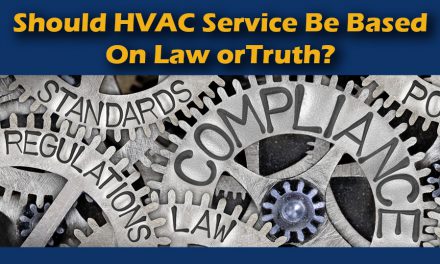
David Holt is Director, Business Training and Coaching for National Comfort Institute
For many HVAC contractors, extremely cold winter weather generates many ‘no heat’ service calls. Emergency calls stack up like firewood and there is substantial pressure on technicians to ‘get in and out’ quickly. During these high-demand weeks, it’s common for technicians to take shortcuts so they can burn through as many calls as possible.
Instead of performing the thorough system diagnostic procedures that the customer deserves, techs resort to ‘quick fixes’ to get the equipment up and running, then they move on. They don’t invest time to search for opportunities to help the customer enjoy the safest, healthiest, most comfortable, and energy efficient system possible.
But, is that really the way you want to run your business? Don’t ALL customers deserve your very best each and every time they use your services? You bet they do! Don’t let a cold winter make you forget who you are: a high-performance HVAC service provider!
Think about the doctor’s office example I shared in my September 2017 Peak Performance Newsletter article, ‘The Curse of Hot Weather.? If your doctor’s team decided to take shortcuts (not measuring your temperature, weight, pulse, and blood pressure) just because they were busy during flu season, how would you feel if you were their patient? Do you really have the flu? Could there be other, more serious issues at play? How would they know what’s going on with you if they’re just guessing? Feels pretty lousy, doesn’t it?
While cold-weather-induced business may be a relief after the mild fall weather killed your phones, remember that great spring weather is right around the corner. The phones will stop ringing once again. While it’s important to get your customer’s heat back up and running quickly, it’s also important to look for opportunities to resolve long-standing problems that might help you fill your spring schedule, too!
The Balancing Act
A large backlog of emergency service calls is both a blessing and a curse. The blessing is that you have plenty of work for your techs – as long as the extreme weather holds out. The curses are many: Even your best customers are impatient and unwilling to wait too long before they resolve their no heat problem by calling your competition. You need twice as many techs to handle the emergency calls but you can’t support them all year so you work your existing crew to death, catching as many calls as possible. Your customers didn’t plan on this extra expense (often occurring around major holidays) so they can’t afford your best solutions. We could go on and on about the curses associated with the ‘wait for it to break’ business strategy!
How can you balance the need to ‘do what’s right? (measure, don’t guess) for EACH customer with the need to ‘stop the bleeding? (quickly get the heat back on) for ALL customers? Balancing their ‘immediate needs’ against what they ‘deserve’ is key to a more predictable and profitable business. You need a strategy that balances both.
A Cold Weather Strategy
Here’s a simple cold weather strategy to consider. When your techs run a ‘no heat’ call, they should ask the customer appropriate questions; properly diagnose the technical problem; present their repair price options; get permission to proceed; make the repair; observe system operation; measure and record the ‘vital signs’ of the system; complete the invoice; debrief the customer; present the invoice; collect payment; thank the customer; and move on to their next call.
The ‘vital signs’ your techs collect on each service call should include important performance indicators such as:
- Rated total static pressure
- Fan type and condition
- Fan speed setting
- Static pressure before and after the filter
- Static pressure before and after the evaporator coil.
Since they are super busy, they can just measure and record these readings to be reviewed and acted upon by the office – when the time is right.
Thinking again about our doctor office analogy, your service techs would be acting like a medical assistant in this cold weather strategy. WebMD.com defines this position as follows:
Medical Assistant: After you’ve checked in, a medical assistant may show you to an examination room. They may check your height, weight, and blood pressure. They also will note your symptoms and pass that information on to the doctor. Medical assistants aren’t allowed to offer medical advice.
That is a perfect description of what you need your techs to do during cold weather! They should measure and record the system’s vital signs; note any safety, health, comfort, and/or efficiency symptoms; pass that information on to the office; make any required repairs to get the unit running. They shouldn’t offer any further advice associated with other symptoms ‘ unless it is a safety issue. Safety issues are ALWAYS top priority and require immediate action!
Filling Your Seed Bag for Upcoming Planting Season
Think of the system vital signs and symptoms that your techs collect during these no heat calls as ‘sales seeds.’ They aren’t ready to be planted right now because you don’t have enough capacity to take on the required additional work. During cold weather months, your job is to collect as many of these seeds as possible, store them in your seed bag, and plant them when you need to harvest more work during milder weather months.
Farmers know that good crops come from good seeds. The same is true in business. Good jobs come from good customers with whom you have an ongoing relationship. When you invest the time to help existing customers understand how your team can help them fully enjoy the benefits of a high performance HVAC system, you’ll find it much easier to keep your crews busy with profitable work all year long.
The Best Time to Plant
According to Stark Bro’s Nursery in Louisiana, Missouri:
‘Think of your planting time as a range of favorable conditions instead of an exact time. For example, you can plant new plants and trees?
- When the ground is not frozen.
- During the day when temperatures are above freezing (32’F) and below 90’F.
- If no extreme weather (blizzard, hail, torrential rain, etc.) is in the forecast.’
This sounds like pretty good advice for the HVAC industry, too!
In my opinion, the best time to take action with ‘sales seeds’ collected during the winter is:
- When outdoor temperatures are beginning to become moderate (check your 10-day forecast regularly!)
- After your installation crews are starting to get caught up (check your install schedule regularly!)
- As soon as you find your sales team just sitting around the office (check your sales schedule regularly!)
The three conditions listed above sound like a perfect description of most HVAC companies during the spring. How about yours?
Don’t let a cold winter make you forget that you’ll need more work in the spring! Do everything you can to plan ahead and collect as many sales seeds as possible. Plant those seeds in the spring and enjoy an abundant crop of new, profitable work generated through opportunities discovered by evaluating and acting upon the system performance data of your existing customer base.
In my next article, I’ll describe a good seed planting strategy that’s sure to create a good crop.
Stay warm out there and be safe!













Recent Comments